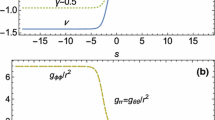Abstract
The aim of the present paper will be to generalize the concept of the ‘Roche coordinates’, introduced previously by the author (see Kopal, 1969, 1970, 1971) for a treatment of dynamical phenomena in close binary systems, to ‘Clairaut's coordinates’ in which the Roche potential of a rotating dipole is replaced by the actual potential of configurations of finite density concentration and arbitrary structure.
By virtue of an identification of the potential with the radial coordinate of our three-dimensional system, the Roche and Clairaut coordinates are both bound to be curvilinear if the star in question departs from spherical form. However, unlike Roche coordinates, the Clairaut coordinates introduced in this paper will not be required to constitute an orthogonal system; and, as a result of the freedom so preserved, their angular variables will be identified with the angles θ and ϕ of spherical polars.
Such an adoption entails advantages and disadvantages. In the orthodox Roche system, the radial coordinate (i.e., the potential ξ) is given to us in a closed form; but their angular variables η and ζ must, in general, be obtained by an integration of partial differential equations constituting the orthogonality conditions. On the other hand for the Clairaut (non-orthogonal) system of coordinates no such integration is necessary — and, in fact, the angular variables can be adopted at will. However, their radial coordinate (i.e., the potential of a star of arbitrary structure and distortion) is no longer available in a closed form and must be constructed by a sequence of successive approximations — a process initiated in the 18th century by Clairaut (1743), which can be developed to any desired accuracy.
As is well known, investigations of the stability of self-gravitating configurations of arbitrary internal structure must be conducted on the basis of fundamental equations of stellar hydrodynamics, which for small oscillations can be reduced to linear forms. In Section 2 the explicit form of these fundamental equations will be set up in Clairaut's coordinates and linearized in Section 3 to the case of small oscillations, while in Section 4 a critical comparison of the Clairaut and Roche coordinates will be made. However their application to rotating stars will be the subject of subsequent papers.
Similar content being viewed by others
References
Clairaut, A. C: 1743,Théorie de la Figure de la Terre, tirée des Principes de l'Hydrostatique, Paris.
Cowling, T. G., and Newing, R. A.: 1949,Astrophys. J. 109, 149.
Darwin, G. H.: 1900,Monthly Notices Roy. Astron. Soc. 60, 82.
de Sitter, W.: 1924,Bull. Astron. Inst. Netherlands 2, 97.
Eddington, A. S.: 1918,Monthly Notices Roy. Astron. Soc. 79, 2, 177.
Kitamura, M.: 1970,Astrophys. Space Sci. 7, 272.
Kochhar, R. K. and Trehan, S. K.: 1974Astrophys. Space Sci. 26, 271.
Kopal, Z.: 1954,Jodrell Bank Ann. 1, 37.
Kopal, Z.: 1960,Figures of Equilibrium of Celestial Bodies, Chapter 2, University of Wisconsin Press.
Kopal, Z.: 1969,Astrophys. Space Sci. 5, 360.
Kopal, Z.: 1970,Astrophys. Space Sci. 8, 149.
Kopal, Z.: 1971,Astrophys. Space Sci. 10, 328.
Kopal, Z.: 1972, inAdvances in Astron. Astrophys, Vol. 9, Academic Press, New York, pp. 1–65.
Kopal, Z.: 1973,Astrophys. Space Sci. 24, 145.
Kopal, Z.: 1974,Astrophys. Space Sci. 27, 385.
Kopal, Z.: 1978,Dynamics of Close Binary Systems, Chapter VI, D. Reidel Publ. Co., Dordrecht, Holland.
Kopal, Z. and Sekender Ali, A. K. M.: 1971,Astrophys. Space Sci. 11, 423.
Kopal, Z. and Kamala Mahanta, M.: 1974,Astrophys. Space Sci. 30, 347.
Lanzano, P.: 1962,Icarus 1, 121.
Laplace, P. S.: 1825,Mécanique Céleste, Vol. 5, Paris.
Legendre, A. M.: 1793,Mémoires de Mathématiques pour 1789, Paris.
Mohan, C. and Singh, V. P.: 1978a,Astrophys. Space Sci.,54, 293.
Mohan, C. and Singh, V. P.: 1978b,Astrophys. Space Sci 56, 109.
Mohan, C. and Singh, V. P.: 1979,Astrophys. Space Sci. 60, 423.
Pekeris, C. L.: 1938,Astrophys. J. 88, 189.
Rahimi-Ardabili, J.: 1979,Astrophys. Space Sci. 66, 325.
Rosseland, S.: 1932,Astron. Publ. Oslo, No. 2.
Author information
Authors and Affiliations
Rights and permissions
About this article
Cite this article
Kopal, Z. Clairaut coordinates and the vibrational stability of distorted stars. Astrophys Space Sci 70, 407–424 (1980). https://doi.org/10.1007/BF00639565
Received:
Issue Date:
DOI: https://doi.org/10.1007/BF00639565




